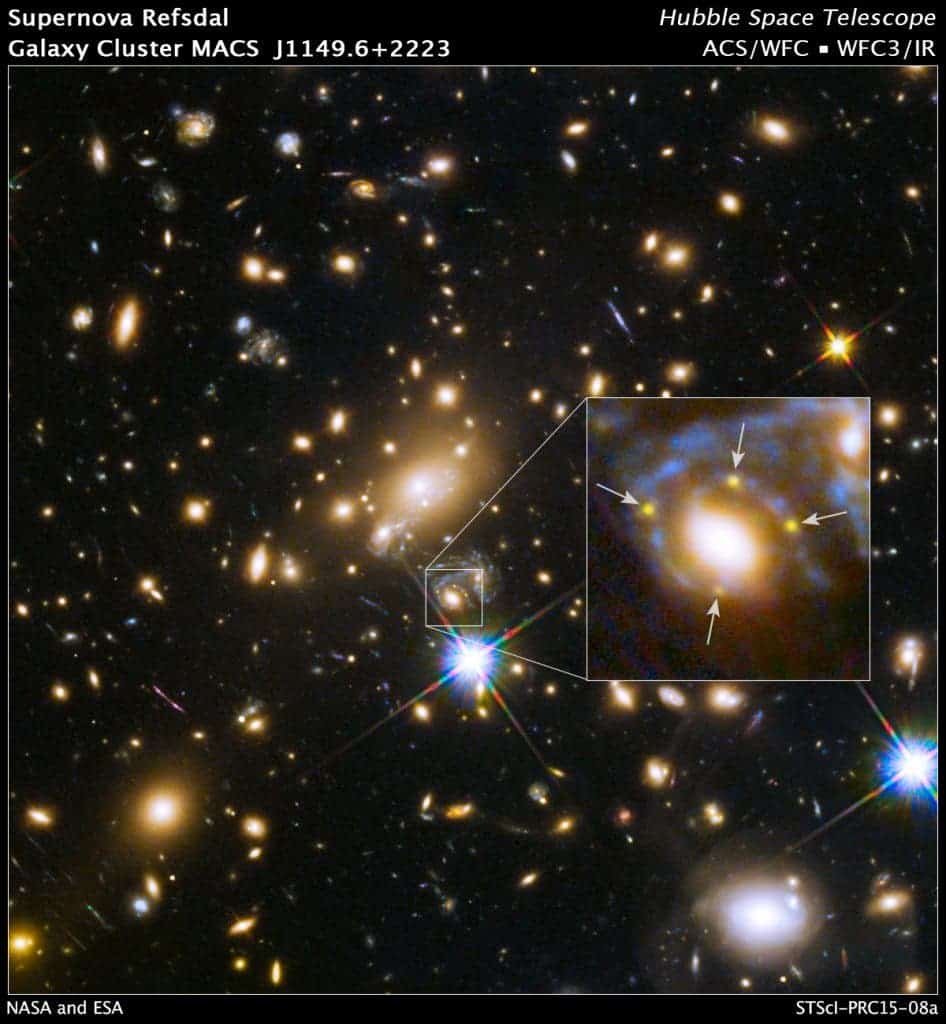According to a new report, a team of astronomers has observed a supernova explode – split into four different images. It’s a “needle in the hay stack” scenario which astronomers were hoping to find for a long time… and now they finally did.

The powerful gravity of a galaxy embedded in a massive cluster of galaxies in this Hubble Space Telescope image is producing multiple images of a single distant supernova far behind it. Both the galaxy and the galaxy cluster are acting like a giant cosmic lens, bending and magnifying light from the supernova behind them, an effect called gravitational lensing. Image via NASA.
“Astronomers have been looking to find one ever since,” said Tommaso Treu of the University of California Los Angeles, USA, the GLASS project’s principal investigator. “And now the long wait is over!”
Astronomers using the NASA/ESA Hubble Space Telescope have, for the first time, discovered a supernova that confirmed one of Einstein’s theories. The initial explosion actually took place more than 9 billion years ago – way beyond Hubble’s range of visibility; however, astronomers managed to observe it using a technique called gravitational lensing – using the light refracted from another galaxy, just like a magnifying glass.
“The supernova appears about 20 times brighter than its natural brightness,” explains the paper’s co-author Jens Hjorth from the Dark Cosmology Centre, Denmark. “This is due to the combined effects of two overlapping lenses. The massive galaxy cluster focuses the supernova light along at least three separate paths, and then when one of those light paths happens to be precisely aligned with a single elliptical galaxy within the cluster, a secondary lensing effect occurs.” The dark matter associated with the elliptical galaxy bends and refocuses the light into four more paths, generating the rare Einstein cross pattern the team observed.
The four images are arranged in a so-called Einstein cross – because Einstein is the one who predicted that such a phenomenon will generate multiple images. Einstein’s cross settings are very rare, and this is the first time it has been done with a supernova. With this approach, the galaxy used as a lens bends light and produces multiple images of the supernova
“It’s perfectly set up, you couldn’t have designed a better experiment,” said Brad Tucker from the Australian National University (ANU).
As a matter of fact, everybody was surprised to make this discovery. Lead author, Dr. Patrick Kelly of the University of California, Berkeley commented:
“I was sort of astounded,” responding to the supernova images from a recording made by the Hubble Telescope last November, adding: “I was not expecting anything like that at all.”
The unique observation will not only help astronomers test Einstein’s theories, but also provide new insight into the nature and distribution of dark matter. Dark matter makes up most of the known Universe, but we pretty much don’t know anything about it – we can just confirm its gravitational effect.
The supernova has been nicknamed Refsdal in honor of Norwegian astronomer Sjur Refsdal, who, in 1964, first proposed using time-delayed images from a lensed supernova to study the expansion of the Universe. It’s estimated that in the next few years we might be able to observe even more images from this supernova.
“The four supernova images captured by Hubble appeared within a few days or weeks of each other and we found them after they had appeared,” explains Steve Rodney of Johns Hopkins University, USA, leader of the Frontier Fields Supernova team. “But we think the supernova may have appeared in a single image some 20 years ago elsewhere in the cluster field, and, even more excitingly, it is expected to reappear once more in the next one to five years — and at that time we hope to catch it in action.”
Source: NASA.









